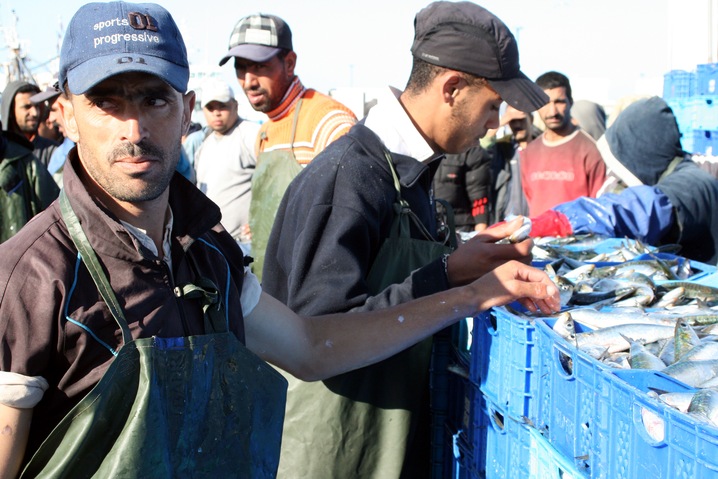A 1,465 mile sand berm divides the territory of Western Sahara in two. The western side of the berm, approximately 80 percent of the territory and all of its coastal land, is de facto controlled by the Moroccan government. The eastern side of the berm, a sandy wasteland, is occupied by the Sahrawi Arab Democratic Republic (SADR), the so-called government of the indigenous population and the Polisario Front, its armed liberation group. Moroccan military posts — staffed by more than 120,000 soldiers — are found every seven miles along the divide, and border crossings are rare. Even without the Moroccan soldiers, civilians wouldn’t venture across the berm; the zone surrounding the berm is one of the most heavily mined areas in the world, and neither the Polisario Front nor the Moroccan military are exactly sure of where they were placed.
This border wall is an enduring reminder of a seemingly endless unresolved dispute. The withdrawal of the Kingdom of Spain in the 1975 Madrid Accords ceded authority over the colony of ‘Spanish Sahara’ to Morocco and Mauritania, but failed to take into account the indigenous Sahrawi of the territory. Despite Sahrawi protest, Morocco and Mauritania were both ceded a portion of the territory. Emboldened by the support of Libya and Algeria, the Polisario Front, a rebel nationalist group of the native Sahrawi people, fought a guerrilla war for independence against Moroccan and Mauritanian control for the next 16 years. The conflict resulted in the displacement of between 40,000 and 80,000 people and the death of between 14,000 and 21,000 people. While a UN-brokered ceasefire halted the violence in 1991, large numbers of indigenous Sahrawi are still displaced in Algeria and Mauritania. In fact, it is estimated that more than 90,000 refugees from Western Sahara reside in Tindouf, Algeria, a refugee camp that serves as the seat of SADR’s government in exile.

Why would the desert territory — unknown to so much of the world — prove so important to its neighbors? The territory of just over 580,000 people, as it turns out, is important for the entire globe. Phosphorus, an essential element within most of the worlds fertilizers, is found in abundance in Western Sahara. In fact, Morocco, with its claim of Western Sahara in addition to its own resources, controls more than 75 percent of the world’s phosphorus. The next biggest producer — China —holds a mere six percent, and most of the world’s reserves of phosphorus are rapidly being depleted. The desert territory of Western Sahara, therefore, is vital zone with some of the world’s best fisheries, and even the potential of rich offshore oil reserves. That being said, Morocco has legitimate century-old claims to the region, and following the “Green March” — an event in which 350,000 Moroccan citizens marched into Western Sahara to claim it for Morocco — a new generation of Moroccan citizens have grown up in the territory, calling it their own home. This, however, does not invalidate SADR claims to Western Sahara.
International stances on the status of Western Sahara vary widely. Algeria, which has long had disputes with neighboring Morocco, actively supports the Polisario Front and their claims of Sahrawi rights to self-determination. Mauritania, too, gave up its claim to Western Sahara and has recognized the rights of self-determination of the Sahrawi. The African Union even recognizes the Polisario Front-led SADR as a state and one of its founding members.
No country officially recognizes Moroccan sovereignty over Western Sahara, but Morocco does have political support. France, the United States, and the UN Security Council have historically been supportive of Morocco, though many see this as merely a move to preserve diplomatic ties with a staunch ally in North Africa. Most Sunni countries of the Middle East and North Africa, too, have proven to be supportive of Morocco, a fellow Sunni state.

The United Nations advocates for a binding status referendum which would legally enforce Moroccan and SADR acceptance of the referendum result. The terms of who may vote in this referendum — whether to include, or not include, Moroccan immigrants to Western Sahara — have prevented it from ever taking place. This solution, however does seem to be the most attractive option if it can be reached. At the very least, it preserves rights to self-determination, while ensuring mutual agreement to avoid further conflict.
The resolution of the Western Sahara conflict should be of particular importance to the wider world. Sahrawi refugee camps in Algeria and Mauritania, set up in locations hardly conducive to human occupation, almost entirely supported by international aid, and with extremely high poverty levels and low rates of employment, have become fertile recruiting sites for extremist groups such as Al-Qaeda in the Islamic Maghreb. The activities of these extremist groups have the potential to destabilize the entire Maghreb, and the loss of Polisario Front fighters to extremist groups could potentially encourage the Moroccan government to reignite a devastating war with its weakened adversary. Furthermore, as the cease-fire draws on without a referendum in the foreseeable future, the Sahrawi have become increasingly frustrated at what they see as illegal resource exploitation of Sahrawi land.
It is in the best interest of the United States and the international community to resolve this intractable dispute. The cease-fire cannot be labeled a success if it once again descends into conflict, and as the cease-fire becomes more tenuous, now is the time for the international community to act. Any resolution to the dispute, barring that of genocide or egregious human rights abuses, is preferable to that of another devastating war. Now 42 years since many Sahrawi first sought refuge in the Tindouf camps of Algeria, it’s time that they return to their former homes across the berm.

